

Compact Muon Solenoid
LHC, CERN
| CMS-HIN-15-008 ; CERN-EP-2017-218 | ||
| Pseudorapidity and transverse momentum dependence of flow harmonics in pPb and PbPb collisions | ||
| CMS Collaboration | ||
| 22 October 2017 | ||
| Phys. Rev. C 98 (2018) 044902 | ||
| Abstract: Measurements of azimuthal angular correlations are presented for high-multiplicity pPb collisions at $\sqrt{s_{\mathrm{NN}}} = $ 5.02 TeV and peripheral PbPb collisions at $\sqrt{s_{\mathrm{NN}}} = $ 2.76 TeV. The data used in this work were collected with the CMS detector at the CERN LHC. Fourier coefficients as functions of transverse momentum and pseudorapidity are studied using the scalar product method, 4-, 6-, and 8-particle cumulants, and the Lee-Yang zeros technique. The influence of event plane decorrelation is evaluated using the scalar product method and found to account for most of the observed pseudorapidity dependence. | ||
| Links: e-print arXiv:1710.07864 [nucl-ex] (PDF) ; CDS record ; inSPIRE record ; CADI line (restricted) ; | ||
| Figures | |

png pdf |
Figure 1:
(Top) The $v_2$ coefficients as a function of $ {p_{\mathrm {T}}} $ in pPb collisions for different ${N_\text {trk}^\text {offline}}$ ranges. (Bottom) Same, but for PbPb collisions. The $v_2\{2, < \Delta \eta >\ > 2\}$ and $v_2\{4\}$ results are from Ref. [38]. For the pPb collisions, the notations p-SP and Pb-SP indicate the pseudorapidity side of the reference event plane, and correspond to the p- and Pb-going directions, respectively. Pseudorapidities are given in the laboratory frame. Systematic uncertainties are indicated by the grey boxes. |
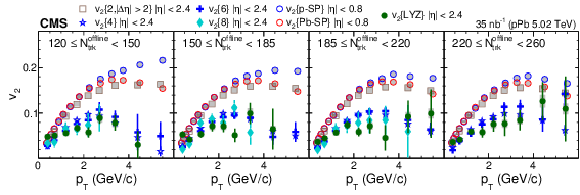
png pdf |
Figure 1-a:
The $v_2$ coefficients as a function of $ {p_{\mathrm {T}}} $ in pPb collisions for different ${N_\text {trk}^\text {offline}}$ ranges. The $v_2\{2, < \Delta \eta >\ > 2\}$ and $v_2\{4\}$ results are from Ref. [38]. The notations p-SP and Pb-SP indicate the pseudorapidity side of the reference event plane, and correspond to the p- and Pb-going directions, respectively. Pseudorapidities are given in the laboratory frame. Systematic uncertainties are indicated by the grey boxes. |

png pdf |
Figure 1-b:
The $v_2$ coefficients as a function of $ {p_{\mathrm {T}}} $ in PbPb collisions for different ${N_\text {trk}^\text {offline}}$ ranges. The $v_2\{2, < \Delta \eta >\ > 2\}$ and $v_2\{4\}$ results are from Ref. [38]. Systematic uncertainties are indicated by the grey boxes. |
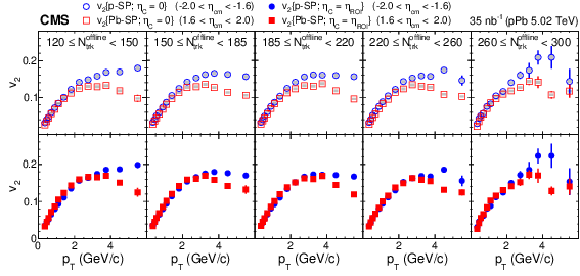
png pdf |
Figure 2:
(Top) Comparison of $v_{2}({p_{\mathrm {T}}})$ distributions located on the Pb-going ($-2.0 < \eta _{\text {CM}} < -1.6$) and p-going (1.6 $ < \eta _{\text {CM}} < $ 2.0) sides of the tracker region, with $\eta _{\text {C}} = $ 0. The notations p-SP and Pb-SP indicate the pseudorapidity side of the reference event plane and correspond to the p- and Pb-going directions, respectively. (Bottom) Same, but with $\eta _{\text {C}} = \eta _{\text {ROI}}$, as discussed in the text. Pseudorapidities are given in the laboratory frame. Systematic uncertainties are indicated by the grey boxes. |

png pdf |
Figure 3:
(Top) Yield-weighted $v_2\{{\text {SP}}\}$ with 0.3 $ < {p_{\mathrm {T}}} < $ 3.0 GeV/$c$ as a function of $\eta $ in pPb collisions for different ${N_\text {trk}^\text {offline}}$ ranges with $\eta _{\text {C}} = $ 0. (Bottom) Same, but with $\eta _{\text {C}} = \eta _{\text {ROI}}$. The notations p-SP and Pb-SP indicate the pseudorapidity side of the reference event plane and correspond to the p- and Pb-going directions, respectively. Pseudorapidities are given in the laboratory frame. Systematic uncertainties are indicated by the grey boxes. |
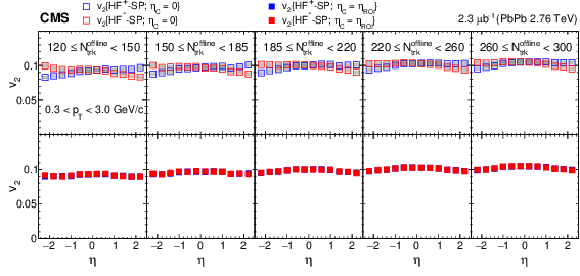
png pdf |
Figure 4:
(Top) Yield-weighted $v_2\{{\text {SP}}\}$ coefficients as a function of $\eta $ in PbPb collisions for different ${N_\text {trk}^\text {offline}}$ ranges with $\eta _{\text {C}} = $ 0. (Bottom) Same, but with $\eta _{\text {C}} = \eta _{\text {ROI}}$. The notations HF$^+$ and HF$^-$ indicate the pseudorapidity side of the reference event plane. Pseudorapidities are given in the laboratory frame. Systematic uncertainties are indicated by the grey boxes. |

png pdf |
Figure 5:
(Top) Yield-weighted $v_2$ values calculated using the scalar product, cumulant, and LYZ methods as a function of $\eta $ in pPb collisions for different ${N_\text {trk}^\text {offline}}$ ranges. (Bottom) Same, but for PbPb collisions. The $v_2\{{\text {SP}}\}$ results are based on the furthest HF event plane in pseudorapidity from the particles of interest. Pseudorapidities are given in the laboratory frame. Systematic uncertainties are indicated by the grey boxes. |
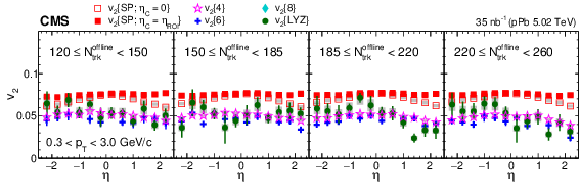
png pdf |
Figure 5-a:
Yield-weighted $v_2$ values calculated using the scalar product, cumulant, and LYZ methods as a function of $\eta $ in pPb collisions for different ${N_\text {trk}^\text {offline}}$ ranges. The $v_2\{{\text {SP}}\}$ results are based on the furthest HF event plane in pseudorapidity from the particles of interest. Pseudorapidities are given in the laboratory frame. Systematic uncertainties are indicated by the grey boxes. |

png pdf |
Figure 5-b:
Yield-weighted $v_2$ values calculated using the scalar product, cumulant, and LYZ methods as a function of $\eta $ in PbPb collisions for different ${N_\text {trk}^\text {offline}}$ ranges. The $v_2\{{\text {SP}}\}$ results are based on the furthest HF event plane in pseudorapidity from the particles of interest. Systematic uncertainties are indicated by the grey boxes. |

png pdf |
Figure 6:
The ratio $\sigma _v$/$ < v > $ in the pPb and PbPb systems as a function of pseudorapidity for the indicated ${N_\text {trk}^\text {offline}}$ ranges. Pseudorapidities are given in the laboratory frame. Systematic uncertainties are indicated by the grey boxes. |
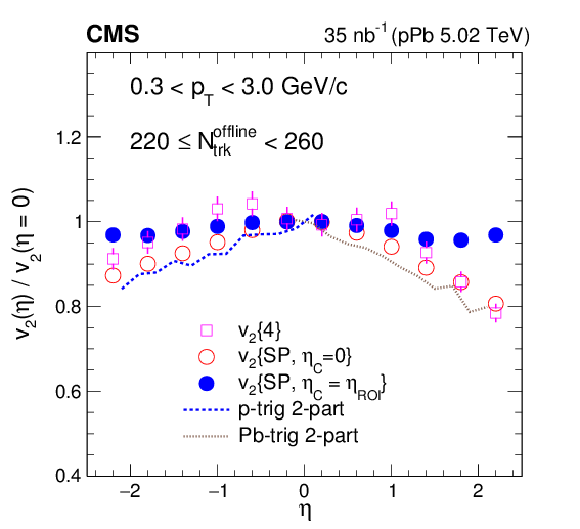
png pdf |
Figure 7:
Comparison of the scalar product ($v_2\{{\text {SP}}\}$) and cumulant ($v_2\{4\}$) results for the ratio $v_{2}(\eta)/v_{2}(\eta = 0)$ with the two-particle correlation results from Ref. [74] for pPb collisions at $ {\sqrt {\smash [b]{s_{_{\mathrm {NN}}}}}} = $ 5.02 TeV and with 220 $ \leq {N_\text {trk}^\text {offline}} < $ 260. The scalar product results with $\eta < $ 0 use the p-side reference event plane with 3.0 $ < \eta < $ 5.0, and the results with $\eta > $ 0 are based on the Pb-side reference event plane with $-5.0 < \eta < -3.0$. The two-particle correlation results of Ref. [74] for p-side (p-trig 2-part) and Pb-side (Pb-trig 2-part) trigger particles are shown without the peripheral $v_{2}$ component subtraction, a correction for nonflow effects that increases the $v_{2}$ harmonics. Pseudorapidities are given in the laboratory frame. Error bars are statistical uncertainties. |
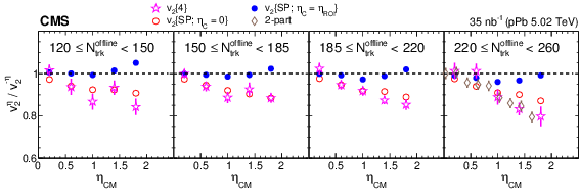
png pdf |
Figure 8:
Ratio of the p- to Pb-going side $v_2$ coefficients at comparable $\eta _{\text {CM}}$ values for pPb collisions. The two-particle correlation results (labelled "2-part") are from Ref. [74]. The reference $HF$ event plane is the one furthest from the particles of interest. |
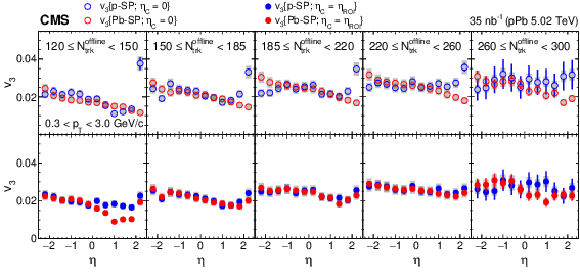
png pdf |
Figure 9:
(Top) The $v_{3}$ values from the scalar product method for pPb collisions at $ {\sqrt {\smash [b]{s_{_{\mathrm {NN}}}}}} = $ 5.02 TeV with $\eta _{\text {C}} = $ 0. (Bottom) Same, but with $\eta _{\text {C}} = \eta _{\text {ROI}}$. The notations p-SP and Pb-SP indicate the pseudorapidity side of the reference event plane and correspond to the p- and Pb-going directions, respectively. Pseudorapidities are given in the laboratory frame. Systematic uncertainties are indicated by the grey boxes. |
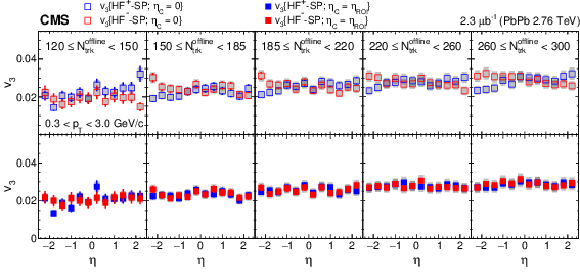
png pdf |
Figure 10:
(Top) The $v_{3}$ values from the scalar product method for PbPb collisions at $ {\sqrt {\smash [b]{s_{_{\mathrm {NN}}}}}} = $ 2.76 TeV with $\eta _{\text {C}} = $ 0. (Bottom) Same, but with $\eta _{\text {C}} = \eta _{\text {ROI}}$. The notations HF$^+$ and HF$^-$ indicate the pseudorapidity side of the reference event plane. Pseudorapidities are given in the laboratory frame. Systematic uncertainties are indicated by the grey boxes. |
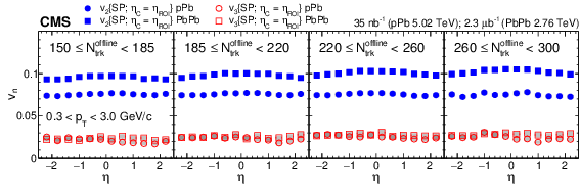
png pdf |
Figure 11:
The $v_{2}$ and $v_{3}$ values for pPb (PbPb) collisions at $ {\sqrt {\smash [b]{s_{_{\mathrm {NN}}}}}}= $ 5.02 (2.76) TeV with $\eta _{\text {C}} = \eta _{\text {ROI}}$. The $v_n\{{\text {SP}}\}$ results are based on the furthest HF event plane in pseudorapidity. Pseudorapidities are given in the laboratory frame. Systematic uncertainties are indicated by the grey boxes. |
| Tables | |

png pdf |
Table 1:
Systematic uncertainties. |
| Summary |
|
The pseudorapidity and transverse momentum dependencies of the elliptic flow $v_{2}$ coefficient are presented for pPb collisions at $\sqrt{s_{\mathrm{NN}}} = $ 5.02 TeV and for peripheral PbPb collisions at $\sqrt{s_{\mathrm{NN}}} = $ 2.76 TeV based on scalar product, multiparticle cumulant, and Lee-Yang zeros analyses. The data are obtained using the CMS detector. The $\eta$ dependence of the triangular flow $v_{3}$ coefficient is also presented based on the scalar product analysis. For the first time, ${p_{\mathrm{T}}}$- and $\eta$-dependent cumulant results are presented based on 6- and 8-particle correlations. The results provide detailed information for the theoretical understanding of the initial state effect and final state evolution mechanism. All methods lead to a similar $\eta$ dependence for the $v_2$ harmonic across the pseudorapidity range studied. The scalar product results are consistently higher than the corresponding multiparticle correlation behavior, with the $v_{2}\{4\}$, $v_{2}\{6\}$, $v_{2}\{8\}$, and $v_{2}\{\text{LYZ}\}$ having comparable magnitude. An analysis of fluctuations suggests their greater influence in the system formed in pPb as compared to that in the PbPb collisions. No significant pseudorapidity dependence is found for the fluctuation component, although there is a small increase in the level of the fluctuations with increasing ${N_\text{trk}^\text{offline}} $ in both the pPb and PbPb systems. A method is presented to account for the possible decorrelation of the event plane angle with an increasing $\eta$ gap between two regions of pseudorapidity. The results suggest that most of the $\eta$ dependence observed using the different methods might be a consequence of the decorrelation effect. Earlier results exploring the $\eta$ dependence of elliptic flow in heavy ion collisions may need to be reassessed based on the presence of such decorrelation effects. Only a small difference is found for the $v_{2}$ coefficients on the Pb- and p-going sides for the pPb collisions once decorrelation effects are considered. This is in contrast to a previous study, in which the decorrelation effects were not considered and where a larger $v_{2}$ value was found on the Pb-going side. If the decorrelation effects are not considered, as is the case with the current cumulant, LYZ, and scalar product analysis with $\eta_{\text{C}} = $ 0, good agreement is found with the previous results. When decorrelation effects are considered, there appears to be very little longitudinal dependence of the flow coefficients near midrapidity. The yield-weighted $v_2$ results of pPb and PbPb collisions at comparable values of ${N_\text{trk}^\text{offline}} $ show a similar $\eta$ dependence, with the heavier system values being about 20% higher than found for pPb collisions. No significant difference is observed for the PbPb $v_3$ values as compared to pPb collisions, suggesting that the $v_3$ results are solely a consequence of fluctuations in the initial-state participant geometry. |
| References | ||||
| 1 | BRAHMS Collaboration | Quark gluon plasma and color glass condensate at RHIC? The Perspective from the BRAHMS experiment | NP A 757 (2005) 1 | nucl-ex/0410020 |
| 2 | PHENIX Collaboration | Formation of dense partonic matter in relativistic nucleus-nucleus collisions at RHIC: Experimental evaluation by the PHENIX collaboration | NP A 757 (2005) 184 | nucl-ex/0410003 |
| 3 | PHOBOS Collaboration | The PHOBOS perspective on discoveries at RHIC | NP A 757 (2005) 28 | nucl-ex/0410022 |
| 4 | STAR Collaboration | Experimental and theoretical challenges in the search for the quark gluon plasma: The STAR Collaboration's critical assessment of the evidence from RHIC collisions | NP A 757 (2005) 102 | nucl-ex/0501009 |
| 5 | ATLAS Collaboration | Observation of a centrality-dependent dijet asymmetry in Lead-Lead collisions at $ \sqrt{s_{\rm NN}}= $ 2.76 TeV with the ATLAS detector at the LHC | PRL 105 (2010) 252303 | 1011.6182 |
| 6 | CMS Collaboration | Observation and studies of jet quenching in PbPb collisions at $ \sqrt{s_{\rm NN}}= $ 2.76 TeV | PRC 84 (2011) 024906 | CMS-HIN-10-004 1102.1957 |
| 7 | S. Voloshin and Y. Zhang | Flow study in relativistic nuclear collisions by Fourier expansion of azimuthal particle distributions | Z. Phys. C 70 (1996) 665 | hep-ph/9407282 |
| 8 | PHOBOS Collaboration | Collision geometry fluctuations and triangular flow in heavy-ion collisions | PRC 81 (2010) 054905 | 1003.0194 |
| 9 | B. H. Alver, C. Gombeaud, M. Luzum, and J.-Y. Ollitrault | Triangular flow in hydrodynamics and transport theory | PRC 82 (2010) 034913 | 1007.5469 |
| 10 | B. Schenke, S. Jeon, and C. Gale | Elliptic and triangular flow in event-by-event (3+1)D viscous hydrodynamics | PRL 106 (2011) 042301 | 1009.3244 |
| 11 | Z. Qiu, C. Shen, and U. Heinz | Hydrodynamic elliptic and triangular flow in Pb-Pb collisions at $ \sqrt{s_{\rm NN}}= $ 2.76 A TeV | PLB 707 (2012) 151 | 1110.3033 |
| 12 | STAR Collaboration | Distributions of charged hadrons associated with high transverse momentum particles in pp and Au+Au collisions at $ \sqrt{s_{\rm NN}}= $ 200 GeV | PRL 95 (2005) 152301 | nucl-ex/0501016 |
| 13 | PHOBOS Collaboration | High transverse momentum triggered correlations over a large pseudorapidity acceptance in Au+Au collisions at $ \sqrt{s_{\rm NN}}= $ 200 GeV | PRL 104 (2010) 062301 | 0903.2811 |
| 14 | STAR Collaboration | Di-hadron correlations with identified leading hadrons in 200 GeV Au+Au and d+Au collisions at STAR | PLB 751 (2015) 233 | 1410.3524 |
| 15 | STAR Collaboration | Three-particle coincidence of the long range pseudorapidity correlation in high energy nucleus-nucleus collisions | PRL 105 (2010) 022301 | 0912.3977 |
| 16 | CMS Collaboration | Long-range and short-range dihadron angular correlations in central PbPb collisions at a nucleon-nucleon center of mass energy of 2.76 TeV | JHEP 07 (2011) 076 | CMS-HIN-11-001 1105.2438 |
| 17 | ALICE Collaboration | Harmonic decomposition of two particle angular correlations in Pb-Pb collisions at $ \sqrt{s_{\rm NN}}= $ 2.76 TeV | PLB 708 (2012) 249 | 1109.2501 |
| 18 | CMS Collaboration | Centrality dependence of dihadron correlations and azimuthal anisotropy harmonics in PbPb collisions at $ \sqrt{s_{\rm NN}}= $ 2.76 TeV | EPJC 72 (2012) 72 | CMS-HIN-11-006 1201.3158 |
| 19 | ATLAS Collaboration | Measurement of the azimuthal anisotropy for charged particle production in $ \sqrt{s_{\rm NN}}= $ 2.76 TeV lead-lead collisions with the ATLAS detector | PRC 86 (2012) 014907 | 1203.3087 |
| 20 | J. Y. Ollitrault | Anisotropy as a signature of transverse collective flow | PRD 46 (1992) 229 | |
| 21 | W. Reisdorf and H. G. Ritter | Collective flow in heavy-ion collisions | Ann. Rev. Nucl. Part. Sci. 47 (1997) 663 | |
| 22 | C. Gale, S. Jeon, and B. Schenke | Hydrodynamic modeling of heavy-ion collisions | Int. J. Mod. Phys. A 28 (2013) 1340011 | 1301.5893 |
| 23 | CMS Collaboration | Observation of long-range near-side angular correlations in proton-proton collisions at the LHC | JHEP 09 (2010) 091 | CMS-QCD-10-002 1009.4122 |
| 24 | ATLAS Collaboration | Observation of Long-Range Elliptic Azimuthal Anisotropies in $ \sqrt{s}= $ 13 and 2.76 TeV pp Collisions with the ATLAS Detector | PRL 116 (2016) 172301 | 1509.04776 |
| 25 | CMS Collaboration | Measurement of long-range near-side two-particle angular correlations in pp collisions at $ \sqrt{s} = $ 13 TeV | PRL 116 (2016) 172302 | CMS-FSQ-15-002 1510.03068 |
| 26 | CMS Collaboration | Evidence for collectivity in pp collisions at the LHC | PLB 765 (2017) 193 | CMS-HIN-16-010 1606.06198 |
| 27 | ATLAS Collaboration | Measurements of long-range azimuthal anisotropies and associated Fourier coefficients for pp collisions at $ \sqrt{s}= $ 5.02 and 13 TeV and p+Pb collisions at $ \sqrt{s_{\mathrm{NN}}}= $ 5.02 TeV with the ATLAS detector | 1609.06213 | |
| 28 | CMS Collaboration | Observation of long-range near-side angular correlations in proton-lead collisions at the LHC | PLB 718 (2013) 795 | CMS-HIN-12-015 1210.5482 |
| 29 | ALICE Collaboration | Long-range angular correlations on the near and away side in p-Pb collisions at $ \sqrt{s_{\rm NN}}= $ 5.02 TeV | PLB 719 (2013) 29 | 1212.2001 |
| 30 | ATLAS Collaboration | Observation of associated near-side and away-side long-range correlations in $ \sqrt{s_{\rm NN}} = $ 5.02 TeV proton-Lead collisions with the ATLAS detector | PRL 110 (2013) 182302 | 1212.5198 |
| 31 | ATLAS Collaboration | Measurement of long-range pseudorapidity correlations and azimuthal harmonics in $ \sqrt{s_{\text{NN}}}= $ 5.02 TeV proton-lead collisions with the ATLAS detector | PRC 90 (2014) 044906 | 1409.1792 |
| 32 | LHCb Collaboration | Measurements of long-range near-side angular correlations in $ \sqrt{s_{\text{NN}}}= $ 5 TeV proton-lead collisions in the forward region | PLB 762 (2016) 473 | 1512.00439 |
| 33 | PHENIX Collaboration | Measurement of long-range angular correlations and azimuthal anisotropies in high-multiplicity p+Au collisions at $ \sqrt{s_{\text{NN}}}= $ 200 GeV | PRC 95 (2017) 034910 | 1609.02894 |
| 34 | PHENIX Collaboration | Quadrupole anisotropy in dihadron azimuthal correlations in central d+Au collisions at $ \sqrt{s_{\text{NN}}}= $ 200 GeV | PRL 111 (2013) 212301 | 1303.1794 |
| 35 | PHENIX Collaboration | Measurement of long-range angular correlation and quadrupole anisotropy of pions and (anti)protons in central d+Au collisions at $ \sqrt{s_{{\rm NN}}}= $ 200 GeV | PRL 114 (2015) 192301 | 1404.7461 |
| 36 | STAR Collaboration | Long-range pseudorapidity dihadron correlations in d+Au collisions at $ \sqrt{s_{\rm NN}}= $ 200 GeV | PLB 747 (2015) 265 | 1502.07652 |
| 37 | PHENIX Collaboration | Measurements of elliptic and triangular flow in high-multiplicity $ ^{3} $He+Au collisions at $ \sqrt{s_{{\rm NN}}}= $ 200 GeV | PRL 115 (2015) 142301 | 1507.06273 |
| 38 | CMS Collaboration | Multiplicity and transverse momentum dependence of two- and four-particle correlations in pPb and PbPb collisions | PLB 724 (2013) 213 | CMS-HIN-13-002 1305.0609 |
| 39 | CMS Collaboration | Evidence for collective multiparticle correlations in p-Pb collisions | PRL 115 (2015) 012301 | CMS-HIN-14-006 1502.05382 |
| 40 | ATLAS Collaboration | Measurement with the ATLAS detector of multi-particle azimuthal correlations in p+Pb collisions at $ \sqrt{s_{\rm NN}}= $ 5.02 TeV | PLB 725 (2013) 60 | 1303.2084 |
| 41 | ATLAS Collaboration | Measurement of multi-particle azimuthal correlations with the subevent cumulant method in pp and p+Pb collisions with the ATLAS detector at the LHC | 1708.03559 | |
| 42 | N. Borghini, P. M. Dinh, and J.-Y. Ollitrault | Flow analysis from multiparticle azimuthal correlations | PRC 64 (2001) 054901 | nucl-th/0105040 |
| 43 | ATLAS Collaboration | Measurement of multi-particle azimuthal correlations in $ pp $, p+Pb and low-multiplicity Pb+Pb collisions with the ATLAS detector | EPJC 77 (2017) 428 | 1705.04176 |
| 44 | PHENIX Collaboration | Measurements of multiparticle correlations in d+Au collisions at 200, 62.4, 39, and 19.6 GeV and p+Au collisions at 200 GeV and implications for collective behavior | 1707.06108 | |
| 45 | P. Bo\.zek and W. Broniowski | Correlations from hydrodynamic flow in p-Pb collisions | PLB 718 (2013) 1557 | 1211.0845 |
| 46 | P. Bo\.zek | Collective flow in p-Pb and d-Pb collisions at TeV energies | PRC 85 (2012) 014911 | 1112.0915 |
| 47 | R. Venugopalan and K. Dusling | Explanation of systematics of CMS p+Pb high multiplicity di-hadron data at $ \sqrt{s_{\rm NN}} = $ 5.02 TeV | PRD 87 (2013) 054014 | 1211.3701 |
| 48 | R. Venugopalan and K. Dusling | Evidence for BFKL and saturation dynamics from dihadron spectra at the LHC | PRD 87 (2013) 051502 | 1210.3890 |
| 49 | S. Alderweireldt and P. Van Mechelen | Obtaining the CMS ridge effect with multiparton interactions | in Proceedings, 3rd International Workshop on Multiple Partonic Interactions at the LHC (MPI@LHC 2011), p. 33 Hamburg, Germany | 1203.2048 |
| 50 | L. He et al. | Anisotropic parton escape is the dominant source of azimuthal anisotropy in transport models | PLB 753 (2016) 506 | 1601.00878 |
| 51 | A. Bilandzic, R. Snellings, and S. Voloshin | Flow analysis with cumulants: Direct calculations | PRC 83 (2011) 044913 | 1010.0233 |
| 52 | R. S. Bhalerao, N. Borghini, and J. Y. Ollitrault | Analysis of anisotropic flow with Lee-Yang zeroes | NP A 727 (2003) 373 | nucl-th/0310016 |
| 53 | STAR Collaboration | Elliptic flow from two and four particle correlations in Au+Au collisions at $ \sqrt{s_{\rm NN}} = $ 130 GeV | PRC 66 (2002) 034904 | nucl-ex/0206001 |
| 54 | J.-Y. Ollitrault and M. Luzum | Eliminating experimental bias in anisotropic-flow measurements of high-energy nuclear collisions | PRC 87 (2013) 044907 | 1209.2323 |
| 55 | P. Bozek, A. Bzdak, and G.-L. Ma | Rapidity dependence of elliptic and triangular flow in proton--nucleus collisions from collective dynamics | PLB 748 (2015) 301 | 1503.03655 |
| 56 | CMS Collaboration | The CMS experiment at the CERN LHC | JINST 3 (2008) S08004 | CMS-00-001 |
| 57 | GEANT4 Collaboration | GEANT4---a simulation toolkit | NIMA 506 (2003) 250 | |
| 58 | S. Porteboeuf, T. Pierog, and K. Werner | Producing Hard Processes Regarding the Complete Event: The EPOS Event Generator | 1006.2967 | |
| 59 | M. Gyulassy and X.-N. Wang | HIJING 1.0: A Monte Carlo program for parton and particle production in high-energy hadronic and nuclear collisions | CPC 83 (1994) 307 | nucl-th/9502021 |
| 60 | CMS Collaboration | Description and performance of track and primary-vertex reconstruction with the CMS tracker | JINST 9 (2014) P10009 | CMS-TRK-11-001 1405.6569 |
| 61 | CMS Collaboration | Azimuthal anisotropy of charged particles at high transverse momenta in PbPb collisions at $ \sqrt{s_{\rm NN}}= $ 2.76 TeV | PRL 109 (2012) 022301 | CMS-HIN-11-012 1204.1850 |
| 62 | CMS Collaboration | Measurement of the elliptic anisotropy of charged particles produced in PbPb collisions at $ \sqrt{s_{\rm NN}}= $ 2.76 TeV | PRC 87 (2013) 014902 | CMS-HIN-10-002 1204.1409 |
| 63 | CMS Collaboration | Measurement of higher-order harmonic azimuthal anisotropy in PbPb collisions at $ \sqrt{s_{\rm NN}} = $ 2.76 TeV | PRC 89 (2014) 044906 | CMS-HIN-11-005 1310.8651 |
| 64 | A. M. Poskanzer and S. A. Voloshin | Methods for analyzing anisotropic flow in relativistic nuclear collisions | PRC 58 (1998) 1671 | nucl-ex/9805001 |
| 65 | E877 Collaboration | Proton and pion production relative to the reaction plane in Au+Au collisions at AGS energies | PRC 56 (1997) 3254 | nucl-ex/9707002 |
| 66 | F. G. Gardim, F. Grassi, M. Luzum, and J.-Y. Ollitrault | Breaking of factorization of two-particle correlations in hydrodynamics | PRC 87 (2013) 031901 | 1211.0989 |
| 67 | P. Bo\.zek, W. Broniowski, and A. Olszewski | Hydrodynamic modeling of pseudorapidity flow correlations in relativistic heavy-ion collisions and the torque effect | PRC 91 (2015) 054912 | 1503.07425 |
| 68 | U. Heinz, Z. Qiu, and C. Shen | Fluctuating flow angles and anisotropic flow measurements | PRC 87 (2013) 034913 | 1302.3535 |
| 69 | K. Xiao, F. Liu, and F. Wang | Event-plane decorrelation over pseudorapidity and its effect on azimuthal anisotropy measurements in relativistic heavy-ion collisions | PRC 87 (2013) 011901 | 1208.1195 |
| 70 | CMS Collaboration | Evidence for transverse momentum and pseudorapidity dependent event plane fluctuations in PbPb and pPb collisions | PRC 92 (2015) 034911 | CMS-HIN-14-012 1503.01692 |
| 71 | A. Bilandzic et al. | Generic framework for anisotropic flow analyses with multiparticle azimuthal correlations | PRC 89 (2014) 064904 | 1312.3572 |
| 72 | B. Alver et al. | Importance of correlations and fluctuations on the initial source eccentricity in high-energy nucleus-nucleus collisions | PRC 77 (2008) 014906 | 0711.3724 |
| 73 | J.-Y. Ollitrault, A. M. Poskanzer, and S. A. Voloshin | Effect of flow fluctuations and nonflow on elliptic flow methods | PRC 80 (2009) 014904 | 0904.2315 |
| 74 | CMS Collaboration | Pseudorapidity dependence of long-range two-particle correlations in pPb collisions at $ \sqrt{s_{\rm NN}}= $ 5.02 TeV | PRC 96 (2017) 014915 | CMS-HIN-14-008 1604.05347 |

|
Compact Muon Solenoid LHC, CERN |

|

|

|

|

|

|